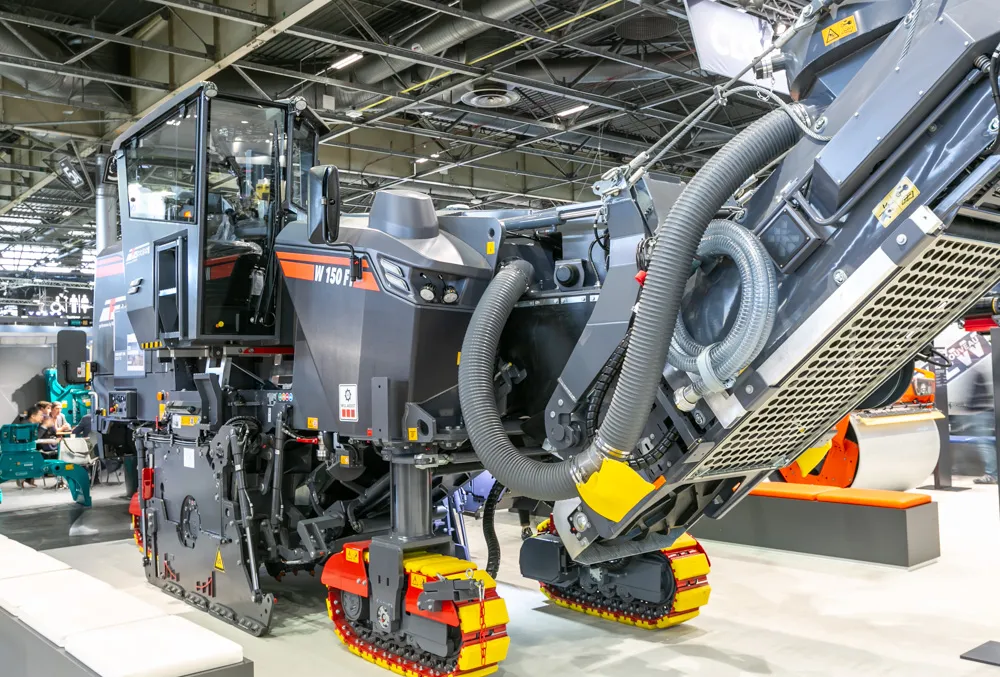Italian firm FAE continues to develop its recycling technology, now offering two stabiliser packages for large and small operations. The smaller SSM and SSM/HP units operate with working depths down to 400mm. Meanwhile the larger SSH unit has a working width of 2.5m, suits towing machines with power outputs from 120-300kW, and can handle working depths down to 500mm.
A key development is the firm’s innovative automatic injection system (AIS), which now offers a more efficient and effective mixing of wate
March 18, 2016
Read time: 3 mins

Italian firm 8067 FAE continues to develop its recycling technology, now offering two stabiliser packages for large and small operations. The smaller SSM and SSM/HP units operate with working depths down to 400mm. Meanwhile the larger SSH unit has a working width of 2.5m, suits towing machines with power outputs from 120-300kW, and can handle working depths down to 500mm.
A key development is the firm’s innovative automatic injection system (AIS), which now offers a more efficient and effective mixing of water or liquid stabilisation agents with materials during the stabilisation process. The AIS package is said to be highly sophisticated and allows the machine operator to preset values accurately, to optimise performance and best suit the working conditions.
The system automatically adjusts itself to take note of the advance speed of the machine, the stabilisation depth and the consistency of materials inside the drum. The AIS package also ensures that the degree of moisture in the mix is optimised to suit the materials, the location and the required specifications of the job in hand.
Sensors located around the drum and flowmeters attached to the liquid feed ensure that the quantities are accurate. The speed of advance is also monitored accurately through a connection to the electronics for the towing vehicle’s drive system or to an optional radar sensor.
The exact quantities being stabilised at any one time are displayed continuously on the screen, so that the operator can see what work is being carried out and that this is to the necessary specification. The AIS also works efficiently with the variable geometry drums of the FAE stabilisers.
The compact SSM stabiliser can cope with towing vehicle power output of 112kW and is offered with an optional hydraulically adjustable back roller that is used to set the working depth as well as to aid with compaction of the treated area. It has a dual transmission that allows the rotor to work at a constant and consistent speed and helps reduce component wear.
The firm offers multiple tooth options for use in different applications and conditions, and for working in rocky soil. Standard features include a double side gear type transmission, a PTO drive shaft with cam clutch and a hydraulic rear hood. The SSM/HP version shares the same compact dimensions but is designed to cope with higher power towing machines of up to 224kW. Other options for the SSM and SSM/HP models include adjustable road type skids, an adjustable dosing blade and different tooth types.
The larger SSH unit meanwhile is said to be suitable for use in soil containing a high clay content and is designed to handle work on larger jobsites. The SSH unit is said to be capable of advance rates of 500-600m/hour, due in part to an innovative design that ensures only the rotor penetrates the ground and reduces traction forces and fuel consumption for the towing vehicle.
A key development is the firm’s innovative automatic injection system (AIS), which now offers a more efficient and effective mixing of water or liquid stabilisation agents with materials during the stabilisation process. The AIS package is said to be highly sophisticated and allows the machine operator to preset values accurately, to optimise performance and best suit the working conditions.
The system automatically adjusts itself to take note of the advance speed of the machine, the stabilisation depth and the consistency of materials inside the drum. The AIS package also ensures that the degree of moisture in the mix is optimised to suit the materials, the location and the required specifications of the job in hand.
Sensors located around the drum and flowmeters attached to the liquid feed ensure that the quantities are accurate. The speed of advance is also monitored accurately through a connection to the electronics for the towing vehicle’s drive system or to an optional radar sensor.
The exact quantities being stabilised at any one time are displayed continuously on the screen, so that the operator can see what work is being carried out and that this is to the necessary specification. The AIS also works efficiently with the variable geometry drums of the FAE stabilisers.
The compact SSM stabiliser can cope with towing vehicle power output of 112kW and is offered with an optional hydraulically adjustable back roller that is used to set the working depth as well as to aid with compaction of the treated area. It has a dual transmission that allows the rotor to work at a constant and consistent speed and helps reduce component wear.
The firm offers multiple tooth options for use in different applications and conditions, and for working in rocky soil. Standard features include a double side gear type transmission, a PTO drive shaft with cam clutch and a hydraulic rear hood. The SSM/HP version shares the same compact dimensions but is designed to cope with higher power towing machines of up to 224kW. Other options for the SSM and SSM/HP models include adjustable road type skids, an adjustable dosing blade and different tooth types.
The larger SSH unit meanwhile is said to be suitable for use in soil containing a high clay content and is designed to handle work on larger jobsites. The SSH unit is said to be capable of advance rates of 500-600m/hour, due in part to an innovative design that ensures only the rotor penetrates the ground and reduces traction forces and fuel consumption for the towing vehicle.









